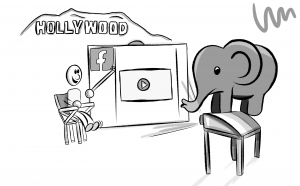 What Marketing Company is a young, but already successful company providing social media marketing services, such as video production, illustration, and animation. What Marketing Company has a reputation for serving companies with innovative and effective campaigns that showcase niche products to relevant audiences. We asked Chris Townsend, one of the company’s directors, for his opinion on what works with video and social media marketing in the travel space right now. Here’s what he had to say ahead of his WYSTC workshop How to Leverage Video Content with Facebook Ads.
What Marketing Company is a young, but already successful company providing social media marketing services, such as video production, illustration, and animation. What Marketing Company has a reputation for serving companies with innovative and effective campaigns that showcase niche products to relevant audiences. We asked Chris Townsend, one of the company’s directors, for his opinion on what works with video and social media marketing in the travel space right now. Here’s what he had to say ahead of his WYSTC workshop How to Leverage Video Content with Facebook Ads.
Thanks for talking with me today, Chris. Maybe you could start by telling us what is the best example of video production in the tourism space you’ve seen this year? And it can’t be one of yours!
#myaussiaadventure was a campaign run by STA travel, which combined creative video with a shareable and eye-catching campaign. The idea was that you had to pick, out of 137 experiences, the places you’d like to visit in Australia, and then a video was created automatically that shared your Aussie Adventure for the chance to win it. The prize was a £2,500 travel card and return flights to Australia.
Do businesses always need professional quality video production, or can good results be achieved in-house or on an iPhone?
No, is the simple answer. That said, there is a lot to be said for User Generated Content, as cameras are getting a lot better now and with the iPhone/gopro you can get some amazing results. DJI, one of the most innovative camera companies, are also creating a range of awesome cameras that are perfect for travel, such as the Osmo mobile – a fully stabilised gimbal for the iPhone.
We started to hear about ‘snackable’ and ‘easily digestible’ content a few years back- especially when it comes to younger audiences. What is the optimum length of a video created for Facebook? Does this differ across social platforms?
Optimum length of the video depends on a range of variables. Mainly though, it’s a question of how engaging the content is! I think you also have to start with a few parameters: What is the call-to-action? Where are people watching? What do you want them to do? Generally, 30 to 60 seconds for Facebook is where you need to be at, in terms of getting your message across.
What do you see as the greatest challenges for tourism and travel businesses in generating and disseminating video content?
Definitely believability. There are too many brands within the industry becoming too ‘beige’. Stock images and videos are a tell-tale sign, amongst others. For a brand to do well in an online world it needs to have real testimonials, real photos to give them credibility.
What’s an example of too ‘beige’ out there right now? How do I know if I’m believable?
People using iStock or Getty video footage, especially aiming at a young travel market; Millennials, Gen X & Y value transparency and if what is advertised isn’t what they are going out to, then they’ll have no problem telling you on social media!
I think the ultimate ‘how do I know if I’m believable’ is if you become a connotation for the brand. For example, AmeriCamp people say ‘I’m doing AmeriCamp this summer’. The reality is that in its simplest form AmeriCamp becomes almost a recruitment company for camps in America. People are actually doing Camp Winadu or Camp Greylock, but because the brand has become so strong, through marketing using video content and photos of people in AmeriCamp t-shirts, it becomes somewhat iconic of a summer camp experience in the States.
What changes have you seen in the way consumers of video content have changed their viewing habits?
85% of Facebook video is watched without sound, which is a massive thing to take into consideration during the creation of video content.
Also, people spend on average 3x more time watching a Facebook live video than one that is not live. When we have streamed video content from client pages in the past, the results have been fantastic for both engagement and views. Also, because of its nature, it offers the viewer a degree of authenticity.

Those are pretty important considerations, it sounds (no pun intended!) Who is doing video without sound right? How do you approach this problem with a client?
Create video content that draws people in, give people a chance to put the sound on, especially for travel! We are working in an industry where we have the opportunity to showcase amazing cities, beautiful landscapes. Start with that. Make your video attractive within the first few seconds. Think of your USP’s. For a brand we work with in Thailand its elephants; everyone wants to visit Thailand and see elephants so we start with that and some shots of beautiful beaches before we put any interviews or audio in. This gives those who are interested a chance to click on a Facebook video which automatically enables the sound.
What do you think will be the most important element of the tourism business marketing mix in five years?
I think the important element of marketing in the next five years will be the same as it is today: understanding where your audience is, so that you can understand how to best target them. We have always worked with travel brands targeting an 18 to 25 demographic, meaning that they spend 80% of their marketing budget on social media.
Hear more tips from Chris Townsend of What Marketing Company during his workshop How to Leverage Video Content with Facebook Ads at the World Youth and Student Travel Conference on Thursday, 28 September 2017.

Recent Comments